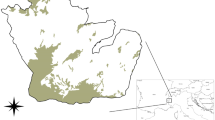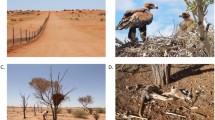Abstract
Species response to habitat loss, fragmentation, or alteration ranges from intolerance and extinction to tolerance and population growth. An ability to increase trophic niche breadth is likely to play a key role in promoting tolerance to habitat change in many species. Howlers (Alouatta spp.) are good examples of these tolerant species. Researchers have related their capacity to thrive well in disturbed habitats to their ability to exploit an eclectic vegetarian diet. Despite >50,000 h of observation of habituated free-ranging groups throughout the distribution of Alouatta, no case of intentional ingestion of animal matter has ever been observed. Here, we report an unexpected trophic niche broadening for free-ranging groups of black-and-gold howlers (Alouatta caraya) living in small (≤2 ha) impoverished habitat islands in the State of Rio Grande do Sul, Brazil. We studied 3 isolated social groups (15–17, 12–14, and 5 individuals) and observed 1 of them preying on birds’ nests. We recorded 19 events of egg-eating during 2274 h of observation in 1 group and 2 suspected cases in another. Our findings highlight the dietary flexibility that characterize howlers and contrast with the widely held view that they observe a strictly vegetarian diet.


Similar content being viewed by others
References
Bicca-Marques, J. C. (2003). How do howler monkeys cope with habitat fragmentation? In L. K. Marsh (Ed.), Primates in fragments: Ecology and conservation (pp. 283–303). New York: Kluwer Academic.
Bicca-Marques, J. C., & Calegaro-Marques, C. (1994a). Exotic plant species can serve as staple food sources for wild howler populations. Folia Primatologica, 63, 209–211.
Bicca-Marques, J. C., & Calegaro-Marques, C. (1994b). Feeding behavior of the black howler monkey (Alouatta caraya) in a seminatural forest. Acta Biologica Leopoldensia, 16, 69–84.
Bravo, S. P., & Zunino, G. E. (1998). Effects of black howler monkey (Alouatta caraya) seed ingestion on insect larvae. American Journal of Primatology, 45, 411–415.
Chitolina, O. P., & Sander, M. (1981). Contribuição ao conhecimento da alimentação de Alouatta guariba clamitans Cabrera, 1940 em habitat natural no Rio Grande do Sul (Cebidae, Alouattinae). Iheringia, Série Zoologia, 59, 37–44.
Crockett, C. M. (1998). Conservation biology of the genus Alouatta. International Journal of Primatology, 19, 549–578.
Crockett, C. M., & Eisenberg, J. F. (1987). Howlers: Variations in group size and demography. In B. B. Smuts, D. L. Cheney, R. M. Seyfarth, R. W. Wrangham & T. T. Struhsaker (Eds.), Primate societies (pp. 54–68). Chicago: The University of Chicago Press.
Crooks, K. R., & Soulé, M. E. (1999). Mesopredator release and avifaunal extinctions in a fragmented system. Nature, 400, 563–566.
Emlen, J. M. (1968). Optimal choice in animals. American Naturalist, 102, 385–390.
Estrada, A., & Coates-Estrada, R. (1996). Tropical rain forest fragmentation and wild populations of primates at Los Tuxtlas, Mexico. International Journal of Primatology, 17, 759–783.
Lens, L., van Dongen, S., Norris, K., Githiru, M., & Matthysen, E. (2002). Avian persistence in fragmented rainforest. Science, 298, 1236–1238.
Martin, P., & Bateson, P. (1993). Measuring behaviour: An introductory guide. Cambridge: Cambridge University Press.
Moynihan, M. (1976). The New World primates: Adaptive radiation and the evolution of social behavior, languages, and intelligence. Princeton: Princeton University Press.
Neville, M. K., Glander, K. E., Braza, F., & Rylands, A. B. (1988). The howling monkeys, genus Alouatta. In R. A. Mittermeier, A. B. Rylands, A. F. Coimbra-Filho & G. A. B. Fonseca (Eds.), Ecology and behavior of neotropical primates (Vol. 2, pp. 349–453). Washington: World Wildlife Fund.
Rodrigues, A. S. L., Pilgrim, J. D., Lamoreux, J. F., Hoffmann, M., & Brooks, T. M. (2006). The value of the IUCN Red List for conservation. Trends in Ecology and Evolution, 21, 71–76.
Schwarzkopf, L., & Rylands, A. B. (1989). Primate species richness in relation to habitat structure in Amazonian rainforest fragments. Biological Conservation, 48, 1–12.
Silver, S. C., Ostro, L. E. T., Yeager, C. P., & Horwich, R. (1998). Feeding ecology of the black howler monkey (Alouatta pigra) in northern Belize. American Journal of Primatology, 45, 263–279.
Urquiza-Haas, T., Serio-Silva, J. C., & Hernández-Salazar, L. T. (2008). Traditional nutritional analyses of figs overestimates intake of most nutrient fractions: a study of Ficus perforata consumed by howler monkeys (Alouatta palliata mexicana). American Journal of Primatology, 70, 432–438.
Acknowledgments
We thank the owners of the study sites for permission and logistical support (ECB, Osório family; ENSC, Mr. Mauro Estácio Azambuja da Silva; BX, Mr. Sérgio Kneuhaus), the Brazilian National Research Council (CNPq, Proc. no. 306090/2006-6), and the World Wildlife Fund (WWF-US) for financial support; our colleagues T. Grant, E. A. Jeckel Neto, V. M. Silva, and M. R. Bogo for help in different steps of this study; and 2 anonymous reviewers for critical comments.
Author information
Authors and Affiliations
Corresponding author
Rights and permissions
About this article
Cite this article
Bicca-Marques, J.C., Muhle, C.B., Prates, H.M. et al. Habitat Impoverishment and Egg Predation by Alouatta caraya . Int J Primatol 30, 743–748 (2009). https://doi.org/10.1007/s10764-009-9373-y
Received:
Accepted:
Published:
Issue Date:
DOI: https://doi.org/10.1007/s10764-009-9373-y




